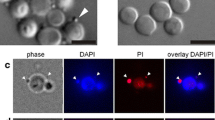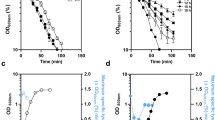Abstract
It is well documented that disturbance of cell surface by some agents triggers compensatory responses aimed to maintain the cell wall integrity in fungi and other organisms. Here, the thermodimorphic fungus Sporothrix globosa, a member of the pathogenic clade of the Sporothrix complex, was propagated in yeast–peptone–dextrose medium under conditions to obtain the mycelium (pH 4.5, 27–28 °C) or the yeast (pH 7.8, 32–34 °C) morphotypes in the absence and presence of the wall-interacting dyes Congo Red (CR) and Calcofluor White (CFW) either alone or in combination. After different periods of time, growth, cell morphology and activity of glucosamine-6-phosphate synthase (GlcN-6-P synthase), an ubiquitous enzyme that plays a crucial role in cell wall biogenesis, were determined. CR and to a lower extent CFW affected growth and morphology of both fungal morphotypes and significantly increased enzyme activity. Notoriously, CR or CR in combination with CFW induced the transient conversion of yeasts into conidia-forming filamentous cells even under culture conditions adjusted for yeast development, most likely as a strategy to evade the noxious effect of the dye. After sometime, hypha returned to yeast cells. An hypothetical model to explain the effect of CR on morphology and enzyme activity based on the possible role of membrane-spanning proteins known as mechanosensors is proposed. Results are discussed in terms of the fungal responses to cell wall damage.










Similar content being viewed by others
Availability of data and materials
All data generated or analysed during this study are included in this published article.
References
Aquino-Piñero E, Rodríguez-del-Valle N (2002) Characterization of a protein kinase C gene in Sporothrix schenckii and its expression during the yeast-to-mycelium transition. Med Mycol 40:185–199
Arellano M, Valdivieso MH, Calonge TM, Coll PM, Duran A, Perez P (1999) Schizosaccharomyces pombe protein kinase C homologues, pck1p and pck2p, are targets of rho1p and rho2p and differentially regulate cell integrity. J Cell Sci 112:3569–3578
Bartnicki-Garcia S, Persson J, Chanzy H (1994) An electron microscope and electron diffraction study of the effect of Calcofluor and Congo Red on the biosynthesis of chitin in vitro. Arch Biochem Biophys 310:6–15
Bermejo C, García R, Straede A et al (2010) Characterization of sensor-specific stress response by transcriptional profiling of wsc1 and mid2 deletion strains and chimeric sensors in Saccharomyces cerevisiae. OMICS A J Integr Biol 14:679–688
Calonge TM, Nakano K, Arellano M et al (2000) Schizosaccharomyces pombe Rho2p GTPase regulates cell wall α-glucan biosynthesis through the protein kinase Pck2p. Mol Biol Cell 11:4393–4401
Elhasi T, Blomberg A (2019) Integrins in disguise—mechanosensors in Saccharomyces cerevisiae as functional integrin analogues. Micro Cell 6:335–355
Fèvre M, Girard V, Nodet P (1990) Cellulose and β-glucan synthesis in Saprolegnia. In: Khun PJ, Trinci APJ, Jung MJ, Goosey MW, Copping LG (eds) Biochemistry of cell walls and membranes in fungi. Springer, Berlin, pp 97–107
García R, Bermejo C, Grau C et al (2004) The global transcriptional response to transient cell wall damage in Saccharomyces cerevisiae and its regulation by the cell integrity signaling pathway. J Biol Chem 279:15183–15195
González-Ibarra J, Milewski S, Villagómez-Castro JC, Cano-Canchola C, López-Romero E (2010) Sporothrix schenckii: purification and partial biochemical characterization of glucosamine-6-phosphate synthase, a potential antifungal target. Med Mycol 48:110–121
Gualtieri T, Ragni E, Mizzi L et al (2004) The cell wall sensor Wsc1p is involved in reorganization of actin cytoskeleton in response to hypo-osmotic shock in Saccharomyces cerevisiae. Yeast 21:1107–1120
Gupta U, Banerjee K, Gabrani R et al (2011) Variability analyses of functional domains within glucosamine-6-phosphate synthase of mycoses-causing fungi. Bioinformation 6:196–199
Haigler CH, Brown RM, Benziman M (1980) Calcofluor white ST alters the in vivo assembly of cellulose microfibrils. Science 210:903–906
Heinisch JJ, Lorberg A, Schmitz HP, Jacoby JJ (1999) The protein kinase C-mediated MAP kinase pathway involved in the maintenance of cellular integrity in Saccharomyces cerevisiae. Mol Microbiol 32:671–680
Herth W (1980) Calcofluor white and Congo red inhibit chitin microfibril assembly of Poterioochromonas: evidence for a gap between polymerization and microfibril formation. J Cell Biol 87:442–450
Huang L, Gao W, Giosa D et al (2016) Whole-genome gequencing and in silico analysis of two strains of Sporothrix globosa. Genome Biol Evol 8(11):3292–3296
Ichinomiya M, Uchida H, Koshi Y et al (2007) A protein kinase C-encoding gene, pkcA, is essential to the viability of the filamentous fungus Aspergillus nidulans. Biosci Biotechnol Biochem 71:2787–2799
Jiménez-Gutiérrez E, Alegría-Carrasco E, Sellers-Moya A et al (2020a) Not just the wall: the other ways to turn the yeast CWI pathway on. Int Microbiol 23:107–119
Jiménez-Gutiérrez E, Alegría-Carrasco E, Alonso-Rodríguez E et al (2020b) Rewiring the yeast cell wall integrity (CWI) pathway through a synthetic positive feedback circuit unveils a novel role for the MAPKKK Ssk2 in CWI pathway activation. FEBS J. https://doi.org/10.1111/febs.15288
Kapteyn JC, Ram AFJ, Groos EM et al (1997) Altered extent of cross-linking of β1,6-glucosylated mannoproteins to chitin in Saccharomyces cerevisiae mutants with reduced cell wall β1,3-glucan content. J Bacteriol 179:6279–6284
Katayama S, Hirata D, Arellano M et al (1999) Fission yeast α-glucan synthase Mok1 requires the actin cytoskeleton to localize the sites of growth and plays an essential role in cell morphogenesis downstream of protein kinase C function. J Cell Biol 144:1173–1186
Kingsbury JM, Heitman J, Pinnell SR (2012) Calcofluor white combination antifungal treatments for Trichophyton rubrum and Candida albicans. PLoS ONE 7(7):e39405
Klis FM, Mol P, Hellingwerf K et al (2002) Dynamics of cell wall structure in Saccharomyces cerevisiae. FEMS Microbiol Rev 26:239–256
Kopecká M, Gabriel M (1992) The influence of Congo red on the cell wall and (1→3)-beta-D-glucan microfibril biogenesis in Saccharomyces cerevisiae. Arch Microbiol 158:115–126
Kumamoto CA (2008) Molecular mechanisms of mechanosensing and their roles in in fungal contact sensing. Nat Rev Microbiol 6:667–673
Lagorce A, Le Berre AV, Aguilar UB et al (2002) Involvement of GFA1, which encodes glutamine-fructose-6-phosphate amidotransferase, in the activation of the chitin synthesis pathway in response to cell-wall defects in Saccharomyces cerevisiae. Eur J Biochem 269:1697–1707
Lagorce A, Hauser NC, Labourdette D et al (2003) Genome-wide analysis of the response to cell wall mutations in the yeast Saccharomyces cerevisiae. J Biol Chem 278:20345–20357
Levin DE, Jung US (1999) Genome-wide analysis of gene expression regulated by the yeast cell wall integrity signalling pathway. Mol Microbiol 34:1049–1057
Lichius A, Zeilinger S (2019) Application of membrane and cell wall selective fluorescent dyes for live-cell imaging of filamentous fungi. J Vis Exp. https://doi.org/10.3791/60613
Linder T (2018) Evaluation of the chitin-binding dye Congo red as a selection agent for the isolation, classification, and enumeration of ascomycete yeasts. Arch Microbiol 200:671–675
Lopes-Bezerra LM, Walker LA, Niño-Vega G et al (2018) Cell walls of the dimorphic fungal pathogens Sporothrix schenckii and Sporothrix brasiliensis exhibit bilaminate structures and sloughing of extensive and intact layers. PLoS Negl Trop Dis 12(3):e0006169
López-Romero E, Reyes-Montes MR, Pérez-Torres A et al (2011) Sporothrix schenckii complex and sporotrichosis, an emerging health problem. Future Microbiol 6:85–102
Maia JCC (1994) Hexosamine and cell wall biogenesis in the aquatic fungus Blastocladiella emersonii. FASEB J 8:848–853
Milewski S (2002) Glucosamine-6-phosphate synthase—the multi-facets enzyme. Biochim Biophys Acta Prot Struct Mol Enzymol 1597:173–192
Milewski S, Kuszczak D, Jȩdrzejczak R et al (1999) Oligomeric structure and regulation of Candida albicans glucosamine-6- phosphate synthase. J Biol Chem 274:4000–4008
Molina M, Gil C, Pla J et al (2000) Protein localisation approaches for understanding yeast cell wall biogenesis. Microsc Res Tech 51:601–612
Nodet P, Capellano A, Fevre M (1990a) Congo red inhibits in vitro β-glucan synthases of Saprolegnia sp. FEMS Microbiol Lett 69:225–228
Nodet P, Girard V, Fevre M (1990b) Morphogenetic effects of Congo red on hyphal growth and cell wall development of the fungus Saprolegnia monoica. J Gen Microbiol 136:303–310
Orlean P (1997) Biogenesis of yeast wall and surface components. In: Pringle JR, Broach JR, Jones E (eds) The molecular and cellular biology of the yeast Saccharomyces. Cell cycle and biology. Cold Spring Harbor Laboratory Press, New York, pp 230–257
Popolo L, Gualtieri T, Ragni E (2001) The yeast cell-wall salvage pathway. Med Mycol 39:111–121
Ram AFJ, Klis FM (2006) Identification of fungal cell wall mutants using susceptibility assays based on Calcofluor white and Congo red. Nat Protoc 2001:2253–2256
Ram AFJ, Arentshorst M, Damveld RA et al (2004) The cell wall stress response in Aspergillus niger involves increased expression of the glutamine:fructose-6-phosphate amidotransferase-encoding gene (gfaA) and increased deposition of chitin in the cell wall. Microbiology 150:3315–3326
Resto S, Rodríguez-Del Valle N (1988) Yeast cell cycle of Sporothrix schenckii. Med Mycol 26:13–24
Ribas JC, Cortés JCG (2016) Imaging septum formation by fluorescence microscopy. In: Nature S (ed) Methods in molecular biology, vol 1369. Humana Press Inc, New York, pp 73–86
Rodríguez-del-Valle N, Rosario M, Torres-Blasini G (1983) Effects of pH, temperature, aeration and carbon source on the development of the mycelial or yeast forms of Sporothrix schenckii from conidia. Mycopathologia 82:83–88
Romeo O, Criseo G (2013) What lies beyond genetic diversity in Sporothrix schenckii species complex? New insights into virulence profiles, immunogenicity and protein secretion in S. schenckii sensu stricto isolates. Virulence 4:203–206
Roncero C, Durán A (1985) Effect of Calcofluor white and Congo red on fungal cell wall morphogenesis: in vivo activation of chitin polymerization. J Bacteriol 163:1180–1185
Sánchez-López JF, González-Ibarra J, Álvarez-Vargas A et al (2015) Isolation of the GFA1 gene encoding glucosamine-6-phosphate synthase of Sporothrix schenckii and its expression in Saccharomyces cerevisiae. Prot Exp Purif 110:57–64
Sánchez-López JF, González-Ibarra J, Macías-Segoviano JI et al (2019) Congo Red affects the growth, morphology and activity of glucosamine-6-phosphate synthase in the human pathogenic fungus Sporothrix schenckii. Arch Microbiol 201:135–141
Selitrennikoff CP (1984) Calcofluor white inhibits Neurospora chitin synthetase activity. Exp Mycol 8:269–272
Smits GJ, Kapteyn JC, Van den Ende H et al (1999) Cell wall dynamics in yeast. Curr Opin Microbiol 2:348–352
Teixeira MM, Rodrigues AM, Clement KM et al (2015) Asexual propagation of a virulent clone complex in a human and feline outbreak of sporotrichosis. Eukar Cell 14:158–169
Valdivia RH, Schekman R (2003) The yeasts Rho1p and Pkc1p regulate the transport of chitin synthase III (Chs3p) from internal stores to the plasma membrane. Proc Natl Acad Sci USA 100:10287–10292
Vermeulen CA, Wessels JGH (1986) Chitin biosynthesis by a fungal membrane preparation. Evidence for a transient non-crystalline state of chitin. Eur J Biochem 158:411–415
Wood PJ (1980) Specificity in the interaction of direct dyes with polysaccharides. Carbohydr Res 85:271–287
Zhang Y, Hagen F, Stielow B et al (2015) Phylogeography and evolutionary patterns in Sporothrix spanning more than 14 000 human and animal case reports. Persoonia Mol Phylogeny Evol Fungi 35:1–20
Acknowledgements
Thanks are given to Dr. Arturo Vega González, Dr. Julio C. Villagómez-Castro, Q.F.B. Lilia Maritza Almanza Villegas and M.C. Carmen Sánchez Leyva, all from Universidad de Guanajuato, for their help in the statistics analysis (AVG), epifluorescence microscopy (JCVC) and expert technical assistance (LMAV, CSL).
Funding
None.
Author information
Authors and Affiliations
Contributions
All authors contributed to the study conception and design. Material preparation, data collection and analysis were performed by Jorge A. Ortiz Ramírez. Mayra Cuéllar-Cruz and Everardo López-Romero wrote the manuscript. All authors read and approved the final manuscript.
Corresponding author
Ethics declarations
Conflict of interest
The authors declare that they have no conflict of interest.
Ethical approval
The authors confirm that not ethical approval was required as the research in this article involved micro-organisms only.
Consent for publication
All authors read and consent to publish this manuscript.
Additional information
Publisher's Note
Springer Nature remains neutral with regard to jurisdictional claims in published maps and institutional affiliations.
Rights and permissions
About this article
Cite this article
Ortiz-Ramírez, J.A., Cuéllar-Cruz, M. & López-Romero, E. Responses of Sporothrix globosa to the cell wall perturbing agents Congo Red and Calcofluor White. Antonie van Leeuwenhoek 114, 609–624 (2021). https://doi.org/10.1007/s10482-021-01545-3
Received:
Accepted:
Published:
Issue Date:
DOI: https://doi.org/10.1007/s10482-021-01545-3




